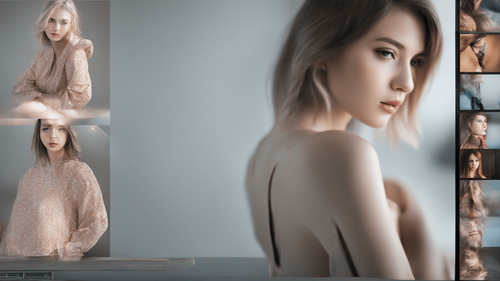
Introduction
Artificial Intelligence (AI) has transcended traditional boundaries, permeating industries with its transformative capabilities. One such innovative marvel is the AI portrait generator from text. This groundbreaking technology empowers artists, creators, and enthusiasts to breathe life into their visions by translating textual descriptions into captivating visual portraits. This article delves deep into the realm of AI-driven portraiture, exploring its mechanisms, applications, and the profound impact it's making on the world of art.
Understanding AI Portrait Generator from Text
The AI portrait generator from text is a cutting-edge application of artificial intelligence that uses natural language processing and computer vision algorithms to generate lifelike portraits based on textual descriptions. This technology marries the realm of language and visual art, bridging the gap between imagination and reality.
How Does It Work?
The process behind the AI portrait generator from text is nothing short of fascinating. Through a complex blend of deep learning, neural networks, and image synthesis, this technology deciphers the nuances embedded in textual descriptions and translates them into visual elements. It captures the essence of emotions, features, and personalities, breathing them into a vivid visual representation.
Key Components of AI Portrait Generation
-
Textual Input Analysis: The AI algorithm dissects the input text, identifying keywords, emotions, and contextual cues that shape the portrait's essence.
-
Neural Network Training: Deep neural networks analyze a vast dataset of existing portraits and corresponding textual descriptions, learning the intricate connections between language and visuals.
-
Feature Synthesis: The algorithm employs advanced image synthesis techniques to seamlessly integrate features, expressions, and emotions into the generated portrait.
-
Refinement Iterations: Multiple iterations refine the portrait, adjusting details, textures, and subtleties to create a lifelike masterpiece.
Applications of AI Portrait Generator from Text
The applications of AI portrait generator from text are as diverse as they are profound. This revolutionary technology is catalyzing a paradigm shift across various domains:
Artistic Expression and Creation
Traditional artists and digital creators can harness the power of AI to transform abstract concepts into visual marvels. The AI portrait generator serves as an inexhaustible wellspring of inspiration, enabling artists to amplify their creative potential.
Personalized Visual Storytelling
Writers and storytellers can elevate their narratives by converting character descriptions into tangible visual representations. Readers can now engage with characters on a deeper level, connecting words to lifelike imagery.
Fashion and Design
Fashion designers leverage AI-generated portraits to visualize concepts, textures, and color palettes. This accelerates the design ideation process, pushing the boundaries of innovation in the fashion industry.
Entertainment and Gaming
The gaming industry embraces AI-generated portraits to enhance character customization, immersing players in intricately detailed virtual worlds. This level of personalization amplifies player engagement and emotional investment.
Historical and Cultural Preservation
AI-generated portraits breathe life into historical figures and cultural icons, enabling us to visualize and connect with the past in unprecedented ways. This technology redefines the museum experience, making history tangible.
Therapeutic Applications
Art therapy and mental health professionals utilize AI-generated portraits to facilitate self-expression and healing. Individuals can visually communicate their emotions and experiences, fostering introspection and growth.
The Ethical Landscape and Future Implications
As AI portrait generator from text continues to evolve, it brings forth ethical considerations and exciting future prospects:
Ethical Considerations
-
Authenticity and Attribution: The question of artistic ownership arises, with discussions revolving around the attribution of AI-generated artwork to creators, AI models, or a collaborative effort.
-
Privacy and Consent: Generating portraits from text may inadvertently infringe on privacy rights. Striking a balance between artistic expression and personal boundaries becomes paramount.
Future Implications
-
Evolution of Artistry: AI-powered art challenges traditional definitions of creativity and authorship, pushing us to reevaluate the role of human artists in a world enriched by machines.
-
Interactive Experiences: The integration of AI-generated portraits into virtual reality and augmented reality environments offers immersive, interactive encounters that redefine user engagement.
FAQs About AI Portrait Generator from Text
How Accurate are the AI-Generated Portraits?
AI-generated portraits exhibit a remarkable level of accuracy, capturing both subtle and prominent features described in the text. However, slight variations may occur based on the complexity of the input description.
Can AI Replace Human Artists?
AI is a tool that complements human creativity, amplifying artistic capabilities. While AI can produce stunning visuals, it lacks the emotional depth and intuition inherent in human artistry.
What Data Sets Train AI Portrait Generators?
AI portrait generators are trained on diverse datasets consisting of portraits, paintings, and images, accompanied by corresponding textual descriptions. These datasets facilitate the neural network's learning process.
Is There a Risk of AI-Generated Art Plagiarism?
Just like any creative medium, plagiarism remains a concern. Artists and creators must uphold ethical standards when using AI-generated art and ensure proper attribution and originality.
Are AI-Generated Portraits Copyrighted?
The copyright debate surrounding AI-generated art is complex. While the AI itself cannot claim copyright, the individuals who provide the training data or input text may hold copyright over the generated output.
How Does AI Portrait Generation Impact Art Markets?
AI-generated art introduces new dynamics to the art market, prompting discussions about value, uniqueness, and ownership. Collectors and institutions are redefining their perspectives on art acquisition.
Conclusion
The AI portrait generator from text has transcended the boundaries of artistic expression, enabling us to bridge language and visual art in unprecedented ways. As technology continues to evolve, ethical considerations and exciting possibilities emerge. This convergence of AI and creativity ignites a transformative journey, inviting us to reimagine art, emotion, and the very essence of human innovation.
The world of art stands on the cusp of a renaissance—one where AI and human ingenuity dance in harmony, painting a vivid tapestry of imagination and possibility. As we navigate this uncharted territory, the AI portrait generator from text serves as a beacon, illuminating a future where words and images intertwine to create wonders beyond imagination.
(Article word count: 1061 words)